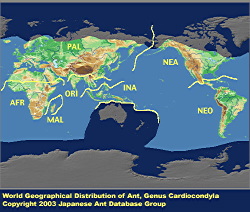
|
genus
|
Cardiocondyla
|
 |
Japanese Name
|
Hadaka-ari-zoku
|
Original Reference
|
|
Emery, C. (1869) Enumerazione dei Formicidi che rinvengonsi nei contorni di Napoli. Annali dell'Accademia degli Aspiranti Naturalisti (2) 2: 1-26.
|
Description
|
|
Total length of workers around 1.5 - 3.5 mm. Head rectangular with rounded occipital border. Mandibles triangular, each usually with 5 teeth. Clypeus widely projecting anteriorly, covering bases of mandibles. Eyes relatively well-developed. Antennae with 12 segments (11 in some species); the apical 3 segments forming a club. Palpal formula 5:3. Dorsal outline of mesosoma almost straight in profile. Propodeal spines varying from absent to long. Petiole slender in most species, with peduncle and subpetiolar process. Postpetiole depressed in profile, broad in dorsal view, wider than long, wider than petiole. Dorsal areas of head and mesosoma lacking hairs. Legs short; middle and hind legs without tibial spurs.
|
|

|
Remarks
|
|
Most species inhabit open areas, nesting in the soil; some nest in decaying tree branches or hollow grass stems. Several are known to produce ergatoid (wingless, more or less worker-like) males, either exclusively or dimorphically (where both winged and ergatoid males are produced). Cardiocondyla includes about 40 species distributed mainly in the Old World tropics and subtropics, with some species in the Palaearctic region (Bolton, 1982). The genus includes tramp species, such as C. nuda, C. wroughtonii and C. emeryi, which have extended their ranges into North America and the Pacific Islands assisted by human commerce. New World records seem highly likely to have originated from Old-World introductions. Five species have been reported from Japan, found in the warm-temperate zone and southwards.
|
References
|
|
- Bolton, B. (1982). Afrotropical species of the myrmicine ant genera Cardiocondyla, Leptothorax, Melissotarsus, Messor and Cataulacus (Formicidae). . Bull. Br. Mus. Nat. Hist. (Ent.), 45, 307-370.
- Enumerazione dei Formicidi che rinvengonsi nei contorni di Napoli. Annali dell'Accademia degli Aspiranti Naturalisti (2) 2: 1-26.
|
Editor
|
|
Original text by Mamoru Terayama, Katsusuke Yamauchi and Masaaki Morisita. English translation by Mamoru Terayama, edited by Robert W. Taylor
|
|